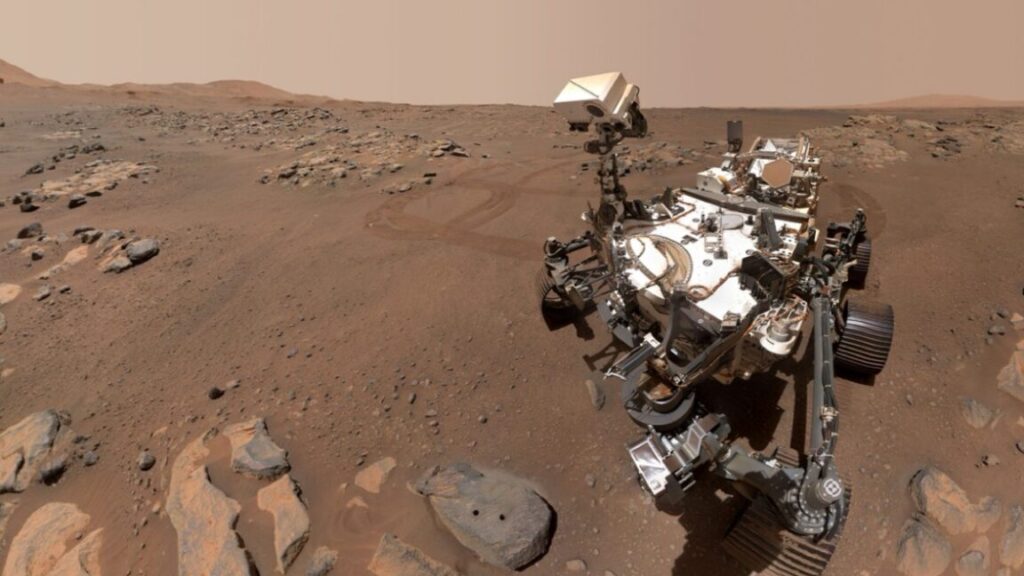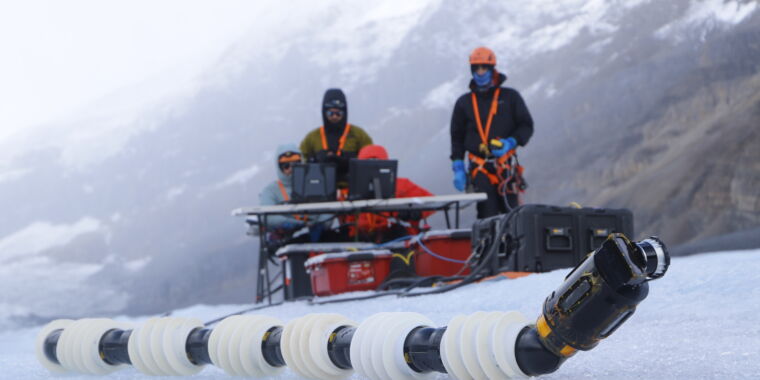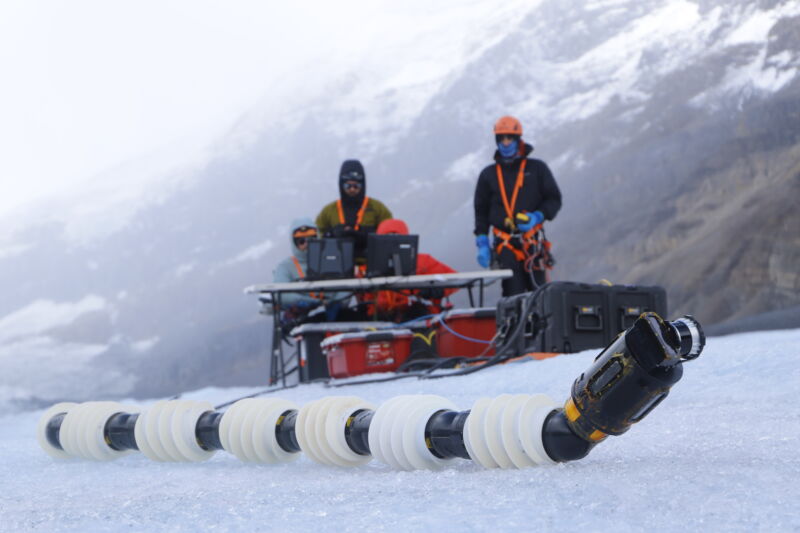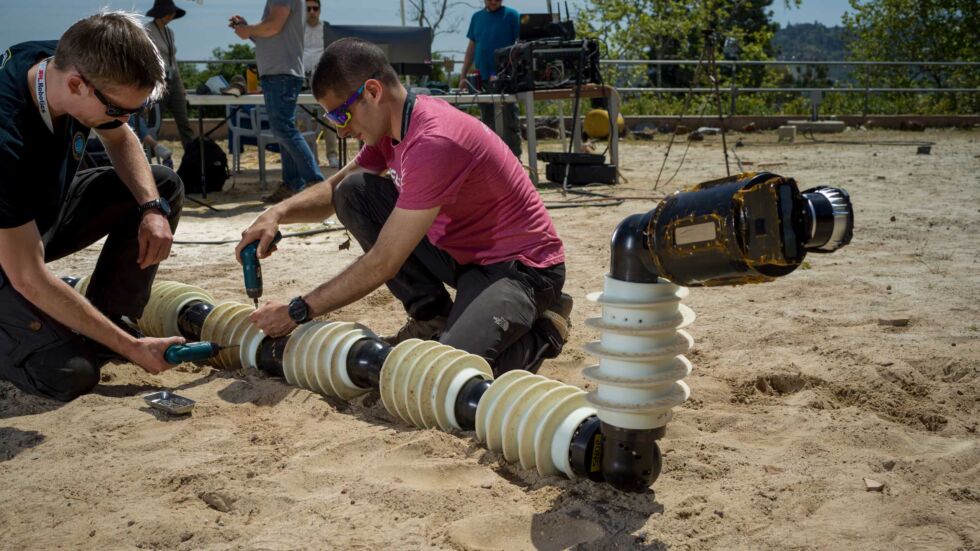Has Perseverance found a biosignature on Mars?
Interpreting the data is tricky because other non-biological processes could account for the findings.
Credit: NASA/JPL-Caltech/MSSS
Last year, we reported on the discovery of an intriguing arrow-shaped rock on Mars by NASA’s Perseverance rover. The rock contained chemical signatures and structures that could have been formed by ancient microbial life. Granted, this was not slam-dunk evidence of past life on Mars, and the results were preliminary, awaiting peer review. But it was an intriguing possibility nonetheless.
Now further analysis and peer review are complete, and there is a new paper, published in the journal Nature, reporting on the findings. It’s still not definitive proof that there was water-based life on Mars billions of years ago, but the results are consistent with a biosignature. It’s just that other non-biological processes would also be consistent with the data, so definitive proof might require analysis of the Martian samples back on Earth. You can watch NASA’s livestream briefing here.
“We have improved our understanding of the geological context of the discovery since [last year], and in the paper, we explore abiotic and biological pathways to the formation of the features that we observe,” co-author Joel Hurowitz, an astrobiologist at Stony Brook University in New York, told Ars. “My hope is that this discovery motivates a whole bunch of new research in laboratory and analog field settings on Earth to try to understand what conditions might give rise to the textures and mineral assemblages we’ve observed. This type of follow on work is exactly what is needed to explore the various biological and abiotic pathways to the formation of the features that we are calling potential biosignatures.”
On February 18, 2021, Perseverance landed in Jezero Crater, a site chosen because rocks resembling a river delta are draped over its rim, indicating that flowing water might have met a lake here in the past. The little rover has multiple cameras for both general imagery and spectral analysis, supplemented by an X-ray instrument. A ground-penetrating radar instrument can reveal layering hidden below the surface; a weather module tracks atmospheric conditions and airborne dust; and a drill on the end of its robotic arm grinds clean spots for analysis. The drill can also core out small cylindrical rock samples.
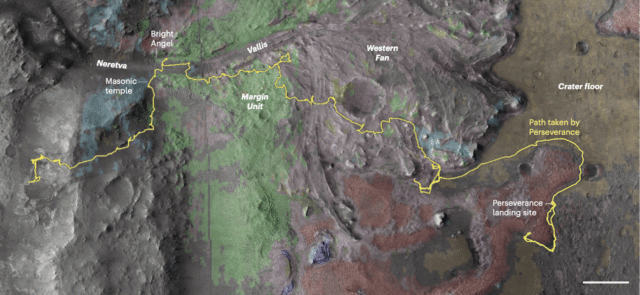
Mineralogical map of the Martian surface explored by the Perseverance rover. Credit: M. Parente et al./Zenodo 2021
By the end of 2021, Perseverance had identified igneous rocks in the Seitah formation on the crater’s floor, containing the mineral olivine surrounded by pyroxene. This combination is known as a cumulate; olivine crystallizes early and can settle to the bottom of a magma body and accumulate, and it’s a common formation in magma chambers on Earth. Scientists thought that Jezero was once a lake; this was evidence of possible volcanic activity.
An arrow-shaped clue
As Ars Space Editor Eric Berger reported last year, the arrow-shaped rock that caused such a stir last year was collected on July 21, 2024, as the rover explored the Neretva Vallis riverbed. The science team operating Perseverance nicknamed the rock Chevaya Falls and subjected it to multiple scans by the rover’s SHERLOC (Scanning Habitable Environments with Raman & Luminescence for Organics & Chemicals) instrument. Samples were taken from two sites known as Bright Angel and Masonic Temple; the arrow-shaped rock came from Bright Angel.
That analysis revealed tiny green specks of iron phosphates that have been chemically reduced, as well as iron sulfide minerals, all embedded in mudstone composed of iron minerals, clays, and calcium sulfates. Those distinctive colorful nodules and specks are a smoking gun for certain chemical reactions (known as redox) rather than microbial life itself. On Earth, microbial life can derive energy from these kinds of chemical reactions, so signs of such reactions suggest a plausible source of energy for microbes on Mars. In addition, there are organic chemicals present on the same rock, consistent with some form of life.
This latest paper confirms those initial findings and also concludes that the iron phosphate in the green specks is most likely vivianite, consistent with prior samples taken from the crater’s Onahu site. The nodules and specks seem to have formed under low-temperature conditions and after the deposition of sediment. And the minerals of interest aren’t evenly distributed throughout the mudstone; they are concentrated in specific zones. All of this taken together suggests that these might be biosignatures, per the authors.
So what needs to happen to definitively confirm these are actual signs of previous life on Mars? NASA has a seven-step process for determining whether something can be confirmed as extraterrestrial life. This is known as the CoLD scale, for Confidence of Life Detection. In this case, the detection of these spots on a Martian rock represented just the first of seven steps. Among other steps, scientists must rule out any non-biological possibility and identify other signals to have confidence in off-world life—i.e., solving the so-called “false positive” problem.
For instance, “Analyses of sulfur isotopes can be used to trace the geochemical and biogeochemical pathways that formed sulfate and sulfides,” Janice Bishop (SETI Institute) and Mario Parente (University of Massachusetts Amherst) wrote in an accompanying perspective. “Such analyses would be needed to determine whether ancient microbes participated in the redox reactions that formed these minerals on Mars.”
Michael Wong, an astrobiologist at Carnegie Science who was not involved in the research, told Ars that he appreciated Hurowotiz et al.’s care in not over-hyping their findings and thinks they make a compelling case. Unlike hints of biosignatures on distant exoplanets, he thinks scientists can have confidence in the Mars data. “We’re right up against the rocks, we’re taking spectra of things that we can get up close and personal with,” he said.
The tricky part is in the interpretation of that data. “I think this is consistent with a potential biosignature,” said Wong. “I wouldn’t get too excited, of course, because there could be interesting geological mechanisms for creating these phenomena that we just haven’t thought of yet.”
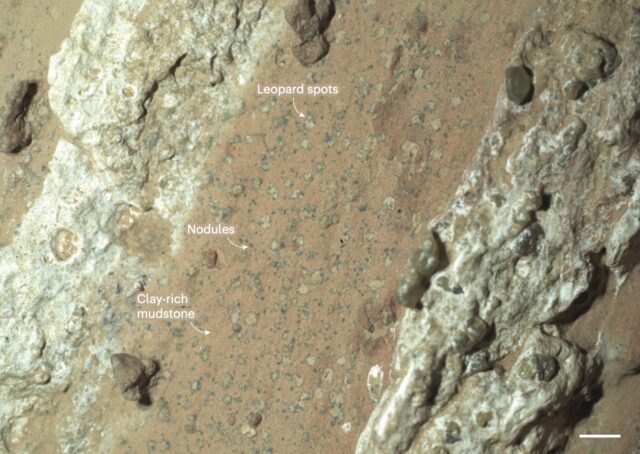
Chemically reduced nodules of greenish material containing the mineral vivianite are embedded in a matrix of red-brown, oxidized clay mineral. More complex ‘leopard spot’ features contain vivianite along with a sulfide mineral. Credit: J. Hurowitz et al. 2025
Still cause for skepticism
That said, “I’d love to know a little bit more about what organics were found and in what abundances,” said Wong. “If you can look at the distribution of, say, amino acids or lipids, these building blocks of life, that can be a really important clue as to whether or not it’s actually life that was responsible here. Life is really good at making molecules that function well, and it doesn’t care about making molecules that don’t play into its metabolism and replication cycles. I’d love to know a little bit more about the isotopic ratios of those organic compounds, because life preferentially absorbs lighter isotopes than heavier ones.”
Sara Walker, an astrobiologist at Arizona State University who was not involved in the study, told Ars that analyses like that of Hurowitz et al. “are often targeted at simple metabolic products or reactions that life on Earth is known to mediate, but which are not uniquely diagnostic of life, e.g. can be produced abiotically,” she said. “It is not in general possible to exhaustively rule out all possible abiotic causes, especially in planetary science contexts where we have limited information, as is always the case for Mars data. A convincing biosignature detection would need to be based on detection of a signature of life that has no false positives.”
Much will depend on NASA’s planned Mars Sample Return mission. Returning pristine specimens from Mars to Earth for analysis in ground-based labs has been a top priority for the planetary science community’s decadal survey process. “The Perseverance rover wasn’t designed to make any definitive claims about biosignatures, but only to look for samples that have the most intriguing clues and would be the most interesting to bring back to Earth so that we can analyze it with all of the fancy instrumentation here,” said Wong.
Getting those samples back has turned out to be a lot more challenging than NASA thought. In 2023, an independent review found ballooning costs and delays threatened the mission’s viability. The effort would likely cost NASA between $8 billion and $11 billion, and the launch would be delayed at least two years until 2030, with samples getting back to Earth a few years later, the review board concluded. NASA put out a call to industry in April of this year to propose ideas on how to return the Mars rocks to Earth for less than $11 billion and before 2040, selecting seven companies to conduct more detailed studies.
“Ultimately, I suspect that we’ll find that there are ways that you can make them under very specific abiotic—perhaps at high temperature—and biological conditions, and we’ll end up at a point where the sample will need to come home so that we can study it and make the final determination for what process made these features,” said Hurowitz. “But the follow-on work will provide testable hypotheses that can guide the examination of the Sapphire Canyon core sample we collected from the Bright Angel formation even before it comes back to Earth.”
According to Walker, while sample return would be ideal, it may not be critical to detection of extraterrestrial biosignatures, or even provide a conclusive determination in the present case. For these kinds of signatures, “There will always be some doubt, whether studied here on Earth or elsewhere,” Walker said. “There are lots of clever means to doing better science for biosignatures on other worlds. I would focus on ones that do not have false positives. But this is a direction that is very new in the field.” Her own research involves using assembly theory and mass spectrometry to identify molecules that are too complex to form abiotically.
Those alternatives might be the best course given the current state of science funding in the US. “In planetary science and astrobiology, the funding cuts to the NASA science mission directorate makes it really difficult to imagine a near future in which we can actually do the analysis,” said Wong. “We need to determine whether or not these ancient Mars rocks do or do not contain signs of alien life. We’re leaving on the doorstep this really intriguing question that we can answer if we brought the samples back to Earth, but we simply aren’t going to. We could be on the steps of a golden age of astrobiology if only we had the willpower to do it.”
DOI: Nature, 2025. 10.1038/s41586-025-09413-0 (About DOIs).
Jennifer is a senior writer at Ars Technica with a particular focus on where science meets culture, covering everything from physics and related interdisciplinary topics to her favorite films and TV series. Jennifer lives in Baltimore with her spouse, physicist Sean M. Carroll, and their two cats, Ariel and Caliban.
Has Perseverance found a biosignature on Mars? Read More »
